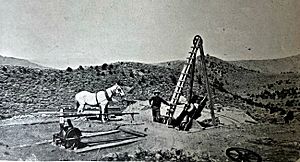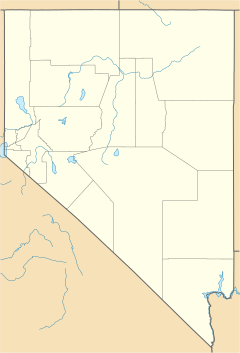Como, Nevada facts for kids
Quick facts for kids
Como, Nevada
|
|
|---|---|
 |
|
| Country | United States |
| State | Nevada |
| County | Lyon County |
| Elevation | 7,116 ft (2,169 m) |
| Time zone | UTC-8 (Pacific (PST)) |
| • Summer (DST) | UTC-7 (PDT) |
| GNIS feature ID | 855999 |
Como is a ghost town located in Lyon County, Nevada. A ghost town is a place where people once lived and worked, but now it's mostly empty and abandoned. Como was once a busy mining town, but today only a few ruins remain.
Contents
The Rise of Como
Imagine finding gold! That's what happened in the Pine Nut Mountains of western Nevada in 1860. This discovery led to the creation of the Palmyra mining district.
The town of Como started in late 1862. It grew quickly because of the gold rush happening nearby. To help people get to Como, a special road was built. This road was a "toll road," meaning people had to pay to use it. It connected Como to the Carson River, and a bridge was also built over the river.
Life in Early Como
In early 1863, a visitor described Como as a busy and growing mining town. It had four hotels, four stores, two stables, eight saloons, and even a brewery! There were also many homes, a tin shop, and a blacksmith shop.
The town was even planning to open a school and start its own weekly newspaper. This newspaper, The Como Sentinel, began publishing in April 1864.
At its busiest, Como had a population of "several thousand" people. The town even got its first rock mill in 1863. This mill, called "The Solomon Davis," used steam power to process the gold ore.
Como's Business and Social Life
Como had all the things a frontier town needed. A very popular spot was the Cross Hotel. It was a fancy place with a comfortable parlor, a bar, and rooms with carpets. It even had a meeting hall for town gatherings.
The Como Sentinel newspaper was an important part of town life. It was published by T.W. Abraham and H.L. Weston. After the Como Sentinel stopped, they went on to publish another newspaper in nearby Dayton.
Famous Faces of Como
One of Como's most famous residents was Alfred Doten. He was a talented writer who moved to Nevada in 1863. Doten worked as a reporter for the Como Sentinel. Later, he became a very important journalist in the Comstock Lode mining area. He even bought a newspaper called the Gold Hill Daily News in 1872.
Doten is also known for his detailed private diaries. He started writing them in 1849 and continued every day until he died in 1903. These diaries give us a great look into life during that time.
Post Office and Native American History
Como had a post office that opened and closed a few times. It first operated from December 1879 to January 1881. Later, it reopened from May 1903 to February 1905.
The Como region was also home to Chief Truckee, a well-known Native American leader. He was the father of Chief Winnemucca and was known for being friendly with white settlers. Chief Truckee helped guide wagon trains and was a scout for famous explorers like Kit Carson and John C. Frémont.
Como Today
Today, Como is completely abandoned. You can still see some foundations of the old buildings. Besides the ruins of the town and old mines, the area also has rock shelters. These shelters were used by Native American tribes long ago. You can also find ancient rock carvings, called petroglyphs, in the area.



